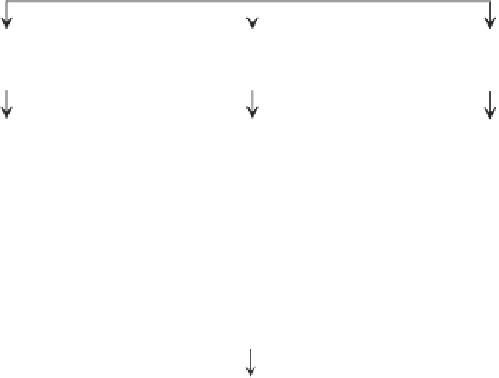Environmental Engineering Reference
In-Depth Information
Equations for SWCC
From zero suction to
completely dry conditions
From air-entry value
to residual conditions
From air-entry value to
completely dry conditions
Fredlund and Pham (2006):
- Volume change versus
two SSVs
- Water content versus
two SSVs
- Simulates water storage
prior to air-entry value
Continuous functions:
4-parameter equations:
(Gitirana and Fredlund, 2005)
3-parameter equations:
(van Genuchten, 1980)
2-parameter equations:
(van Genuchten and Burdine,
1953);
m
= 2/(1
−
n
)
(van Genuchten and Mualem,
1976);
m
= 1/(1
−
n
)
(Gardner, 1958)
Fredlund and Xing (1994):
- 3-parameter equation
- Correction factor to
zero water content
and 1,000,000 kPa
Discontinuous functions; 2-parameter equations:
(Brooks and Corey, 1964; Campbell, 1974)
Figure 5.37
Categorization of SWCC equations based on portion of SWCC that is well defined
for engineering applications.
stress path dependent and is able to more clearly describe
the water storage character of the soil for a wider range
of loading and soil suction conditions. The SWCC model
commences with an initially slurry material.
eight USDA soil classification system groups. The Akaike
(1974) information criterion statistical indicator was used to
assess the “fit” of each of the SWCC equations. The average
Akaike information was obtained from fitting each SWCC
equation to the SWCC data sets (Sillers, 1997).
The results showed that the Fredlund and Xing (1994)
equation performed the best with an Akaike number of
−
5.4.2 Comparative Studies of SWCCs
A number of statistical studies have been undertaken where a
variety of SWCC equations have been best fit to data sets of
laboratory test results. Tinjum et al. (1997) undertook a study
that applied several empirical SWCC equations to measured
data sets. A conclusion from the study was that both two-
parameter and three-parameter SWCC equations could be
best fit to laboratory data; however, the three-parameter
equations provided a better fit due to the greater flexibility of
the equation. Tinjum et al. (1997) also suggested that it was
appropriate to use estimated SWCCs for many geotechnical
and geoenvironmental engineering applications.
Leong and Rahardjo (1997) undertook a review of sev-
eral empirical SWCC equations by applying each equation
to a database of laboratory measurements. It was noted that
the SWCC equations with the highest number of soil fit-
ting parameters provided the closest fit to the data sets. The
Fredlund and Xing (1994) SWCC equation was found to
“perform marginally better” than the van Genuchten (1980)
equation. The Fredlund and Xing (1994) equation is found
to perform much better than other SWCC equations when
the data set contained measurements where some of the soil
suction measurements were greater than residual suction.
Figure 5.38 shows the results of a study in which a total of
nine SWCC equations were best fit to a database contain-
ing 231 soils (Sillers, 1997). The soil data sets contained
1007. Note that the more negative the Akaike number,
the better the equation fit. The next best performing SWCC
McKee and Bumb (1987) (Fermi assumption)
McKee and Bumb (1984) (Boltzmann assumption)
Gardner (1956)
van Genuchten (1980)-Burdine (1953)
Brooks and Corey (1964)
van Genuchten (1980)-Mualem (1976)
Brutsaert (1966)
van Genuchten (1980)
Fredlund and Xing (1994)
−
300
−
500
−
700
−
900
−
1100
−
1300
Averaged Akaike information criterion
Figure 5.38
Averaged Akaike information criterion for various
empirical SWCC equations.
















Search WWH ::

Custom Search